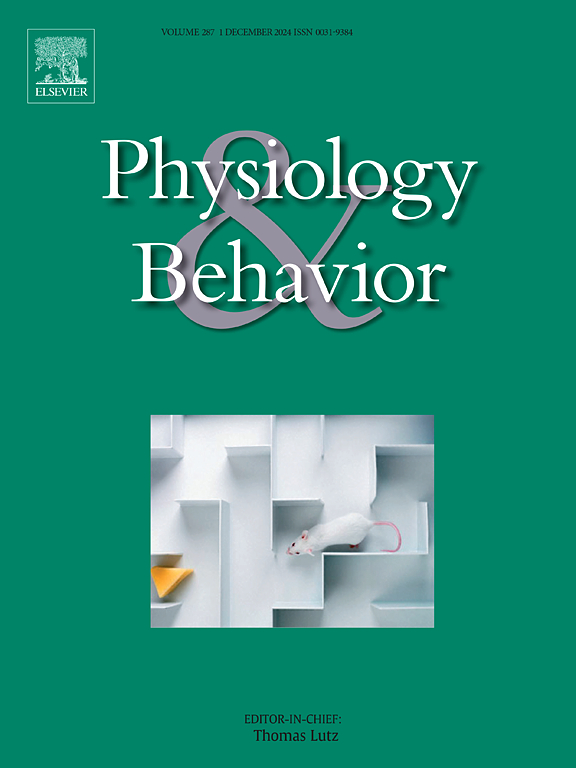Assessing the interconnected behavioral and physiological underpinnings of amphibian responses to fungal infection
IF 2.5
3区 医学
Q2 BEHAVIORAL SCIENCES
引用次数: 0
Abstract
Pathogens inflict various costs onto their hosts from sublethal changes in physiology and behavior to intense pathology and mortality. The timing of host immune responses and concomitant changes in behavior may be jointly underpinned by an increase in glucocorticoid hormones. The temporal and causal links between these interrelated responses to infection remain equivocal in many host-pathogen systems. Here, using a fungal pathogen implicated in global amphibian declines, Batrachochytrium dendrobatidis (Bd), we examined sublethal consequences of infection in the Cuban tree frog (Osteopilus septentrionalis). Specifically, we tracked changes in the neuroendocrine stress response by measuring urinary corticosterone (CORT) metabolites as well as immunological activation via neutrophil/lymphocyte (N/L) ratios over three consecutive rounds of Bd exposure. Additionally, we measured both exploratory behavior and activity level in open field arenas to evaluate whether infection-mediated changes in behavior and stress physiology coincided. Pathogen-exposed individuals began testing positive for Bd after two rounds of exposure. After the third exposure, Bd-positive frogs had higher CORT levels compared to control frogs. While infection load was not associated with N/L ratio, CORT concentrations showed a negative correlation with N/L ratio, suggesting a link between endocrine activity and immune regulation. Furthermore, there were no differences in exploratory behaviors or activity levels between control and Bd-exposed frogs. The lack of a relationship between N/L ratios and infection load may indicate a lag between neuroendocrine and immunological responses in this host-parasite system. This is further supported by the delayed increase in CORT levels only after three rounds of pathogen exposure. Alternatively, the lack of a relationship may be due to the immunosuppressive capability of Bd. The varied impacts of infection on physiological biomarkers indicates a greater need for researchers to consider simultaneous changes to behavior, neuroendocrine, and immunological measures of stress in future host-pathogen studies.
评估两栖动物对真菌感染反应的相互关联的行为和生理基础。
病原体给宿主造成各种各样的损失,从生理和行为的亚致死变化到剧烈的病理和死亡。宿主免疫反应的时间和随之而来的行为变化可能是由糖皮质激素增加共同支撑的。在许多宿主-病原体系统中,这些相互关联的感染反应之间的时间和因果关系仍然不明确。在这里,我们使用一种与全球两栖动物数量下降有关的真菌病原体——树蛙壶菌(Bd),研究了古巴树蛙(Osteopilus septentrionalis)感染的亚致死后果。具体来说,我们通过测量尿皮质酮(CORT)代谢物以及中性粒细胞/淋巴细胞(N/L)比连续三轮Bd暴露来追踪神经内分泌应激反应的变化。此外,我们测量了在开阔场地的探索行为和活动水平,以评估感染介导的行为变化和应激生理是否一致。接触病原体的个体在两轮接触后开始检测出Bd阳性。在第三次暴露后,与对照青蛙相比,bd阳性青蛙的CORT水平更高。虽然感染负荷与N/L比值无关,但CORT浓度与N/L比值呈负相关,提示内分泌活性与免疫调节之间存在联系。此外,对照组和暴露于bd的青蛙在探索行为或活动水平上没有差异。N/L比率与感染负荷之间缺乏关系可能表明在这个宿主-寄生虫系统中神经内分泌和免疫反应之间存在滞后。只有在三轮病原体暴露后,CORT水平才会延迟增加,这进一步支持了这一点。或者,缺乏这种关系可能是由于Bd的免疫抑制能力。感染对生理生物标志物的不同影响表明,在未来的宿主-病原体研究中,研究人员更需要考虑应激的行为、神经内分泌和免疫措施的同时变化。
本文章由计算机程序翻译,如有差异,请以英文原文为准。
求助全文
约1分钟内获得全文
求助全文
来源期刊

Physiology & Behavior
医学-行为科学
CiteScore
5.70
自引率
3.40%
发文量
274
审稿时长
47 days
期刊介绍:
Physiology & Behavior is aimed at the causal physiological mechanisms of behavior and its modulation by environmental factors. The journal invites original reports in the broad area of behavioral and cognitive neuroscience, in which at least one variable is physiological and the primary emphasis and theoretical context are behavioral. The range of subjects includes behavioral neuroendocrinology, psychoneuroimmunology, learning and memory, ingestion, social behavior, and studies related to the mechanisms of psychopathology. Contemporary reviews and theoretical articles are welcomed and the Editors invite such proposals from interested authors.
 求助内容:
求助内容: 应助结果提醒方式:
应助结果提醒方式:


